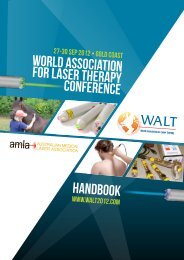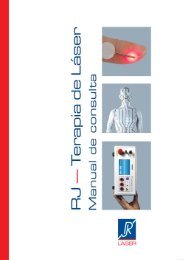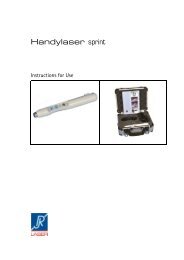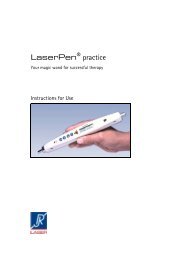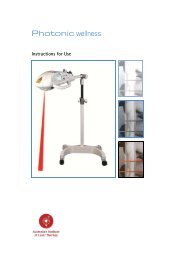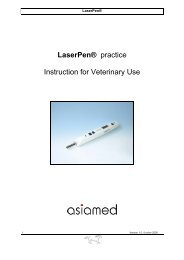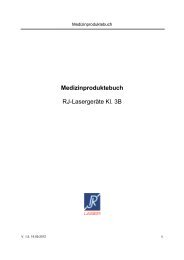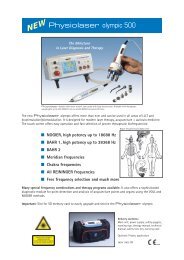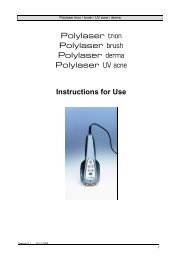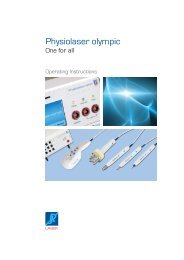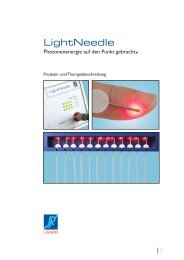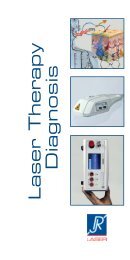You also want an ePaper? Increase the reach of your titles
YUMPU automatically turns print PDFs into web optimized ePapers that Google loves.
<strong>Laser</strong> <strong>probes</strong><br />
For every need<br />
User manual
Contents<br />
1 The probe product line ..................................................................................... 4<br />
2 Introduction ......................................................................................................... 5<br />
3 Safety information .............................................................................................. 6<br />
General information<br />
Intended use<br />
Liability disclaimer<br />
Safety standards<br />
4 Safety precautions .............................................................................................. 8<br />
5 Delivery contents and accessories ...............................................................10<br />
6 Applications .......................................................................................................12<br />
7 Types of <strong>probes</strong> .................................................................................................14<br />
8 Start up ...............................................................................................................15<br />
9 Working with <strong>probes</strong> ......................................................................................17<br />
Remote functions<br />
Probe display<br />
Key functions<br />
Therapy mode<br />
10 Mobile use ..........................................................................................................23<br />
11 Error messages .................................................................................................24<br />
12 Maintenance .......................................................................................................25<br />
2
13 Physical principles of laser therapy ...............................................................26<br />
Continuous wave and pulsed <strong>probes</strong><br />
Energy power output using continuous wave <strong>probes</strong><br />
Energy power output using pulsed <strong>probes</strong><br />
Formular for therapy<br />
14 Technical data ....................................................................................................36<br />
Explanation of the icons<br />
15 Guarantee and disposal ...................................................................................41<br />
16 Manufacturer information ..............................................................................42<br />
3
1<br />
2<br />
1<br />
The probe product line 1<br />
2<br />
3<br />
Multi-cluster <strong>probes</strong><br />
For two-dimensional applications,<br />
Reimers & Janssen offers pulsed<br />
and continuous wave <strong>probes</strong> with<br />
various wavelengths.<br />
CW multi-cluster probe*<br />
8x55 mW / 785 nm (infrared)<br />
+ 4x40 mW / 655 nm (red)<br />
2 control keys, “<strong>Laser</strong> On” indicator.<br />
Pulsed multi-cluster probe<br />
5x30 W / 904 nm (infrared)<br />
Display, 2 control keys, “<strong>Laser</strong> On”<br />
* This CW multi-cluster probe is also<br />
required in the use of CW multi-cluster<br />
probe derma<br />
4<br />
5<br />
6<br />
Single <strong>probes</strong><br />
All <strong>probes</strong> for precise spot applications<br />
are equipped with a display and four<br />
control keys.<br />
CW single probe 500mW<br />
810 nm (infrared)<br />
Pulsed single probe<br />
50 W / 904 nm (infrared)<br />
Additional single probe without<br />
imaging:<br />
CW single probe 50mW<br />
785 nm (infrared)<br />
Single probe 150mW<br />
638 nm (red)<br />
CW single probe 200mW<br />
670 nm (red)<br />
5<br />
4<br />
4
Introduction 2<br />
Your <strong>RJ</strong> laser probe<br />
Thank you for choosing a Reimers & Janssen laser probe. Our extensive probe product line<br />
provides the optimum laser probe for every therapy and diagnosis need.<br />
Whether it’s a surface probe, a single probe or laser needles, all our highly specialised laser<br />
<strong>probes</strong> are operated with the same control unit: the Physiolaser olympic. With this modular<br />
design, we can combine technological innovations with a well-designed control concept.<br />
This has several advantages for you as a therapist. Once you are familiar with the intuitive<br />
operation of your control unit, you can use other <strong>probes</strong> in basically the same way. Thus, if<br />
you wish to purchase a new probe for other applications, there will be little change from<br />
your usual operation.<br />
Your Physiolaser olympic automatically detects which probe is attached and “identifi es” your<br />
preferred settings. With Physiolaser olympic you can even operate two therapy <strong>probes</strong> and a<br />
diagnostic probe simultaneously.<br />
The modular design will also always allow you to benefi t from the newest research<br />
innovations, because your control unit can be easily updated with the most recent therapy<br />
products.<br />
With Reimers & Janssen laser <strong>probes</strong>, you can make the best of the diverse possibilities for<br />
gentle laser therapy for you and your patients.<br />
<strong>RJ</strong> <strong>Laser</strong> <strong>probes</strong><br />
For every need<br />
5
Safety information 3<br />
General information<br />
This device consists of a laser probe that can only be operated together with a Physiolaser<br />
olympic.<br />
Therefore, before operating your probe you must thoroughly read the user manual for<br />
your control unit.<br />
The instructions that follow supplement the user manual of the Physiolaser olympic regarding<br />
special functions of your probe. In addition, they describe the commissioning of the device<br />
and indicate hazards associated with its use.<br />
All individuals who use, care for, service and supervise this device must read and follow<br />
the instructions.<br />
This user manual must always be kept with the device and must be transferred ownership<br />
along with the laser probe.<br />
Intended use<br />
Your laser probe is an electrical device that is intended exclusively for use in medical<br />
practices and clinics and should only be operated under constant supervision.<br />
This laser device should only be operated by trained medical professionals that have been<br />
instructed in the handling of the device and in the dangers associated with laser radiation as<br />
well as in the compliance with the accident prevention regulation “<strong>Laser</strong> radiation” and the<br />
IEC 60825-1 “Safety with laser equipment”.<br />
Liability disclaimer<br />
You should use your laser probe only for the purposes described in this user manual and<br />
only under supervision!<br />
Your laser probe should only be operated with accessories approved by Reimers & Jansen<br />
GmbH and only with a Reimers & Janssen control unit. Currently, this includes the<br />
Physiolaser olympic or the Photonic 500 (device types 160A and 160S).<br />
6
Repair and maintenance work should also only be performed by Reimers & Janssen GmbH<br />
or an authorized <strong>RJ</strong> service station.<br />
The manufacturer is not liable for the device and the consequences resulting from operation<br />
or applications that are not described within this user manual. The manufacturer<br />
reserves the right to make changes based on technological improvements.<br />
Safety standards<br />
The <strong>probes</strong> conform to the following international safety standards:<br />
• IEC 60601-1 Safety of medical electrical devices<br />
• IEC 60601-1-2 Electromagnetic compliance<br />
• IEC 60601-1-6 Usability<br />
• IEC 60601-2-22 Safety of diagnostic and therapeutic laser devices<br />
• IEC 60825-1 Safety of laser radiation<br />
7
Safety precautions 4<br />
Emergency shutdown<br />
Press fi rmly on the red “Emergency Stop” button on your control unit, turn the key<br />
switch to “off” and remove the “Remote control plug” from the safety locking device.<br />
Treatment room<br />
Operate the laser only indoors. The room in which the laser is located must comply with<br />
the requirements of the Accident Prevention Regulation “<strong>Laser</strong> radiation”. All<br />
entrances must display a laser warning sign in compliance with IEC 60825-1. Refl ective<br />
objects, mirrors and chrome surfaces must be removed.<br />
Personnel<br />
The laser should be operated only by trained medical professionals. Personnel must be<br />
instructed in the handling of the device and in the dangers associated with laser radiation.<br />
The operator of a Class 3B laser device should have access to a radiation expert or preferably<br />
a radiation control offi cer who is has professional experience protecting against<br />
and controlling the hazards associated with laser, and who will be responsible for the supervision<br />
of the protective measures against the hazards of laser. Children may enter the<br />
treatment room only as patient and should be under constant supervision.<br />
Radiation injuries<br />
Avoid direct or scattered radiation to the eyes. Do not look directly into the laser<br />
radiation output area, since visible and invisible laser radiation can cause injury to the eye.<br />
<strong>Laser</strong> protective eyewear typ SPERIAN 3199-21160<strong>RJ</strong> conforming to the European norm<br />
EN 207 must always be worn within the treatment room during treatment.<br />
Take precautions when performing therapy in the head region!<br />
When treating patients with darkly pigmented skin, birthmarks, tattoos, etc, be aware that<br />
there is a risk of burning because melanin or colour in the skin tissue absorbs the light<br />
Reduce the power or energy output with pigmented skin.<br />
8
Risk of infection<br />
Keep the probe at a distance of approx. 1 cm above wounds or infected skin, because there<br />
is a risk of infection through contact transmission of germs.<br />
After each treatment, disinfect your probe as described in the chapter Care and Maintenance<br />
on page 28. If you use an applicator, disinfect the applicator after each treatment in<br />
order to minimize the risk of patient infection.<br />
Risk of burning<br />
With high power output and longer treatment times, the probe tip can overheat. In this<br />
case, avoid direct skin contact by using a cap or applicator; otherwise you may burn the<br />
skin. Alternatively, reduce the power output or treatment time (see also page 22).<br />
Prevent unauthorised use<br />
The Physiolaser olympic is equipped with a key switch to prevent unauthorised use. The laser<br />
can be operated only with the key inserted.<br />
When the laser is not in use, the key should always be removed and stored separate from<br />
the unit in order to prevent unauthorised use.<br />
Registration<br />
Operators of the Physiolaser olympic must be registered as an operator of a Class 3B laser<br />
device with the professional association prior to the fi rst commissioning of the device.<br />
Please consider the national governmental rules and regulations for this class 3B laser<br />
device.<br />
Decommissioning in the event of a hazard<br />
If you believe that the device can no longer be operated safely, it should be<br />
decommissioned to prevent against further use and to send it to the retailer<br />
for repair.<br />
Such cases include:<br />
• parts of the housing or the probe cable have visible damage,<br />
• the device no longer functions properly,<br />
• the device is to be stored for a long period under adverse conditions or is to be<br />
transported,<br />
• the display indicator fails or is illegible.<br />
9
Delivery contents and<br />
accessories<br />
Product contents<br />
• laser probe, convex lens 523<br />
• carrying case<br />
Accessories<br />
Reimers & Janssen manufactures not only laser <strong>probes</strong> in various power output classes<br />
and wavelengths; we also offer other products for your CW single <strong>probes</strong>. These applicators<br />
can be easily screwed onto the standard product, to allow for additional uses.<br />
Available applicators that fi t all CW single <strong>probes</strong><br />
Product Length Diameter* Product No. Illustration<br />
Dental applicator 7 cm 4 mm 5202<br />
Dental applicator ditto 2 mm 5204<br />
Dental wand<br />
Dental wand<br />
7 cm<br />
(angled<br />
60°)<br />
5 cm<br />
(straight)<br />
8 mm 5207<br />
ditto 5208<br />
5<br />
10
Product Length Diameter* Product No. Illustration<br />
Convex lens 10 mm 523<br />
Quartz tip<br />
attachment<br />
Quartz tip<br />
attachment<br />
PDD/PDT Universal<br />
Attachment<br />
(one way)<br />
PDD/PDT<br />
Endo attachment<br />
(One way)<br />
2 cm 2 mm 5241<br />
dito 4 mm 5251<br />
2 cm 0.8 mm 5206<br />
2 cm 0.4 mm 5205<br />
*Diameter of the light power output opening<br />
11
Applications 6<br />
Treatment range<br />
Reimers & Janssen laser <strong>probes</strong> can be used for a wide range of treatments in dermatology,<br />
rheumatology, orthopaedics, physiotherapy, sports medicine and veterinary medicine<br />
as well as dentistry.<br />
On your Physiolaser olympic control unit there is a variety of individually adjustable therapy<br />
programmes. To use these, read the user manual of your control unit.<br />
Your probe may be used for irradiation of the skin.<br />
Indications<br />
The devices is intended to emit energy in the infrared spectrum to provide topical heating<br />
for use when heat is indicated in the temporary relief of minor muscle and joint pain, muscle<br />
spasm, pain and stiffness associated with arthritis, and promoting relaxation of the muscle<br />
tissue.<br />
Limitations<br />
As manufacturers we advise against the radiation of the following organs and areas:<br />
• eyes<br />
• areas near the thyroid gland and other endocrine glands<br />
• testicular regions<br />
• epiphyseal regions in children<br />
• open fontanel<br />
• foetuses or in the areas over the uterus of pregnant women<br />
• dark, pigmented or coloured skin, regions with dark hair<br />
• non radiation in the head area in patients with (tendency for) epilepsy<br />
12
In addition, we advise against treatment of patients with the following indications:<br />
• cytostatic immunosuppression<br />
• tumour/cancer patients<br />
13
Probe types 7<br />
Continuous wave and Superpulsed <strong>probes</strong><br />
Within its product range, Reimers & Janssen offers two types of lasers: CW <strong>probes</strong> and<br />
pulsed <strong>probes</strong>. CW <strong>probes</strong>, also known as continuous wave <strong>probes</strong>, provide a continuous laser<br />
beam, whereas pulsed <strong>probes</strong> emit extremely short light pulse in succession.<br />
With both probe types, the light output can be controlled by frequency modulation. The<br />
Physiolaser automatically determines the attached probe and makes available the appropriate<br />
programme.<br />
You may use therapy programs with pre-programmed frequency modulation or simply programme<br />
the frequencies yourself (individual protocols). For detailed information on this, please<br />
consult the user manual for your Physiolaser.<br />
Please note when using frequencies that the energy output for CW <strong>probes</strong> is always half<br />
that of continuous wave operation – independent of the frequency.<br />
In contrast, with pulsed <strong>probes</strong> – which generally cannot be operated with continuous wave<br />
– the energy is dependent on the selected frequency. The highest energy is emitted at the<br />
maximum frequency. The power output cannot be changed with pulsed <strong>probes</strong>.<br />
If you would like to know the precise relationship between the amount of energy and the<br />
power output with continuous wave and pulsed <strong>probes</strong>, please read the chapter Physical<br />
Principles of <strong>Laser</strong> Therapy on page 29.<br />
14
Start up 8<br />
Testing for damage during transport<br />
Begin by testing your probe for damage that may have occurred during transport, i.e.<br />
whether the housing components or the probe cable have visible damage. If you have a<br />
probe with a display, remove the protective cover from the display and test the indicator.<br />
If you discover any damage, do not operate your probe. Instead, contact your retailer.<br />
Self-test<br />
Your probe does not require any particular start up procedure. You can connect the probe<br />
cable to the control unit at any time. However, if you are going to operate your Physiolaser<br />
for the fi rst time, please read the user manual for your control unit prior to connecting<br />
your probe.<br />
Turning on your control unit or connecting the probe to a device that is already on will initiate<br />
a self test on the connected probe, during which the status indicator blinks briefl y. If<br />
this does not occur, your laser probe may be connected to the diagnostic socket.<br />
Status indicator blinks during the self-test.<br />
Automatic probe detection<br />
The Physiolaser automatically detects a newly connected probe, and a corresponding symbol<br />
is depicted in the therapy selection display.<br />
If the corresponding symbol does not appear, the software of your control unit may need<br />
to be updated. This can occur if your probe is new to an existing control unit. In that case,<br />
there is an SD card included with your probe, with which you can easily perform the update<br />
yourself. An applicable instruction guide will also be included. Contact your retailer.<br />
15
In the therapy selection display, both laser<br />
connectors will be presented: <strong>Laser</strong> 1 corresponds<br />
to the left connector, <strong>Laser</strong> 2 to<br />
the right.<br />
Probe symbols<br />
The different probe types are easily distinguished<br />
by different symbols.<br />
Pulsed single probe<br />
Pulsed multi-cluster<br />
probe<br />
Light Needle<br />
CW single probe<br />
CW multi-cluster<br />
probe<br />
Photonic satellite<br />
Charge <strong>Laser</strong> Test Power<br />
Diagnosis<br />
<strong>Laser</strong><br />
If the “invalid” probe symbol appears, you<br />
have attached a invalid probe into a laser<br />
connector.<br />
16
Working with <strong>probes</strong> 9<br />
Remote functions<br />
Operation of your probe takes place primarily<br />
via the touchscreen of your Physiolaser<br />
olympic. Therefore it is required to read the<br />
instructions for your control unit.<br />
In this user manual, only the functions<br />
specifi c to the <strong>probes</strong> are described:<br />
For comfortable use, all <strong>probes</strong> are equipped<br />
with buttons with which essential program<br />
functions can be selected directly from the<br />
probe (remote function).<br />
Probe display<br />
Other than the CW multi-cluster probe, all<br />
probe have a two-line status display.<br />
If your Physiolaser olympic is in “Stand By”<br />
mode, this is indicated in the probe<br />
display. In this state, the buttons on the probe<br />
are inactive.<br />
As soon as the “Ready” symbol appears in<br />
the therapy selection display, the remote<br />
functions can be used.<br />
These instructions do not describe<br />
the special functions of the Light<br />
Needle. This laser needle acupuncture<br />
probe has its own user manual.<br />
Other than the Light Needle, all <strong>probes</strong> can<br />
be used in remote function.<br />
<strong>RJ</strong>‐<strong>Laser</strong><br />
Stand by<br />
“Stand By” display in the probe display<br />
17
Single probe button functions<br />
CW multi-cluster probe button<br />
functions<br />
LASER ON<br />
FREQUENCY<br />
LASER<br />
Superpulsed multi-cluster probe<br />
button functions<br />
Start/Stop<br />
Short: Start therapy; stop therapy<br />
Long: Start therapy with reduced<br />
diagnostic power<br />
Right arrow<br />
Change to the next therapy<br />
program<br />
Left arrow<br />
Change to the previous therapy<br />
programme<br />
Group<br />
Short: Change to the next<br />
program group<br />
Long: Change to the next<br />
programme set<br />
F<br />
Change to the next therapy<br />
program<br />
Start/Stop<br />
Short: Start therapy; stop therapy<br />
Pause<br />
1x start therapy<br />
2x stop therapy<br />
Start/Stop<br />
Short: Start therapy; stop therapy<br />
18
Change therapy set (single <strong>probes</strong>)<br />
If you have installed multiple therapy sets<br />
on your Physiolaser, you can change to the<br />
next therapy set by pressing and holding the<br />
Group button.<br />
If you have installed a therapy set with multiple<br />
program groups, advance to the next<br />
program group by pressing briefl y.<br />
Basic<br />
cont. beam<br />
The program group and therapy program<br />
are shown on the probe display.<br />
Selecting the therapy program<br />
You can change the next or previous therapy<br />
program with single <strong>probes</strong> by pressing<br />
the arrow keys within the program group.<br />
You can change the next therapy program<br />
with the CW multi-cluster <strong>probes</strong> by pressing<br />
the “F” button.<br />
The pulsed multi-cluster probe does not<br />
have this function.<br />
Basic<br />
F2<br />
The display on your control unit indicates<br />
that the “continuous wave” therapy programme<br />
in the “basic” program group of the<br />
“Basic therapy” program set has been selected<br />
for the attached probe.<br />
19
Therapy mode<br />
At any time you can begin therapy from the<br />
therapy selection mode by briefl y pressing<br />
on the “Start/Stop” button.<br />
This is also possible if another probe is chosen<br />
or if another probe is already present in<br />
therapy mode. In both cases, the most recently<br />
used therapy program will begin.<br />
Do not forget to equip yourself and<br />
your patient with laser protective<br />
eyewear prior to commencing therapy.<br />
Once you press the start button, a two-second<br />
tone will sound and the status LED will<br />
blink to indicate the start of therapy. During<br />
this time, you can always press the “Start/<br />
Stop” button to stop the program again, if,<br />
for example, you have forgotten to put on<br />
the protective glasses.<br />
During the two seconds, the multi-cluster<br />
<strong>probes</strong> and the superpulsed single <strong>probes</strong><br />
send out a visible, but harmless pilot beam,<br />
which helps you to fi nd the precise therapy<br />
location.<br />
During the therapy, the status indicator will<br />
remain on. The end of therapy will be indicated<br />
with a long tone. However, the current<br />
therapy program can be stopped at any time<br />
by holding the “Start/Stop” button.<br />
You can interrupt the therapy with the<br />
pulsed multi-cluster iprobe using the pause<br />
button, and resume using the “Start/Stop”<br />
button.<br />
Since all buttons are active in therapy<br />
mode, at any time during a treatment<br />
you can also change the program.<br />
F2 1.1<br />
:150mW 04:45<br />
Therapy program<br />
Energy output<br />
Power output<br />
Remaining therapy time<br />
The status LED blinks when you press the<br />
“Start/ Stop” button until the onset of the<br />
therapy mode. The status indicator remains<br />
on during therapy.<br />
Stop the current therapy programme using<br />
the Start/Stop button.<br />
20
Reduced RAC power<br />
All single <strong>probes</strong> offer the option to reduce<br />
the therapy power output to 5mW for RAC<br />
testing.<br />
To do this, simply press the “Start/Stop”<br />
button on your probe longer rather than<br />
shorter.<br />
The program sequence is identical on the<br />
therapy display and the probe display – if<br />
present – will indicate “R 5mW” in the power<br />
output section.<br />
Changing the contrast<br />
If the probe display is diffi cult to read, for<br />
example in bright sunlight, you can adjust<br />
the display on your control unit in the “<strong>Laser</strong><br />
settings” menu.<br />
Cont. beam 0.8<br />
R: 5mw 59:19<br />
Start/Stop button<br />
“5mW” is indicated in the probe display<br />
“<strong>Laser</strong> 1 setting” display on the Physiolaser<br />
“-” or “+” changes the contrast of the probe<br />
display.<br />
21
Caution when using the<br />
CW single probe 500mW<br />
The tip of the CW single probe 500mW can<br />
overheat with full power output and longer<br />
treatment times.<br />
As a result, you should not use this probe<br />
without an attachment or applicator.<br />
Otherwise, the probe tip can get too hot<br />
and may result in burns during contact<br />
with the skin.<br />
The CW single probe 500mW should not<br />
be operated at full power output for longer<br />
than 5 minutes. If you want to use it for longer,<br />
you should pause treatment for at least<br />
one minute every 5 minutes.<br />
Caution when using the pulsed<br />
<strong>probes</strong><br />
The maximum recommended frequency<br />
modulation with superpulsed <strong>probes</strong><br />
is 10,000 Hz. For therapeutic purposes we<br />
have enabled frequencies up to 40,000 Hz,<br />
for example, to allow more energy to be<br />
transferred in a shorter period. However,<br />
this results in an accelerated ageing of the<br />
laser diodes.<br />
The laser diodes should therefore be monitored<br />
more closely than usual, or in any<br />
case in the context of the annual safety<br />
check (see also the chapter Care and Maintenance<br />
on page 28)<br />
Caution when using the<br />
infrared <strong>probes</strong><br />
Every now and then you should test the<br />
functioning of your infrared <strong>probes</strong> with the<br />
help of the laser test diode on your control<br />
unit. Read the chapter on the <strong>Laser</strong><br />
Function Test in the user manual for your<br />
Physiolaser.<br />
22
Mobile use 10<br />
Sample scenarios<br />
With the compact Physiolaser olympic you<br />
can also use your probe during battery operation.<br />
How long you can actually use the<br />
probe in practice, depends on various factors,<br />
for example the ambient temperature<br />
and the adjusted parameters.<br />
CW multi-cluster probe in CW<br />
operation<br />
1.5 hours<br />
9 treatments are possible<br />
Treatment time: 10 Min<br />
Power output: 400 mW<br />
Therapy program: CW<br />
CW single probe 500 mW at 10 kHz<br />
1.5 hours<br />
9 treatments are possible<br />
Treatment time: 10 Min<br />
Power output: 500 mW<br />
Therapy program: CW<br />
We have conducted a practical test with<br />
both probe types as a reference point for<br />
your work: rechargeable battery fully charged,<br />
each therapy session 10 minutes at<br />
room temperature. How many sessions are<br />
possible under these conditions?<br />
Pulsed single probe at 10 kHz<br />
5 hours<br />
24 treatments are possible<br />
Treatment time: 10 Min<br />
Frequency: 10,000 Hz<br />
Power output 50 W<br />
Pulsed multi-cluster probe at 10 kHz<br />
4 hours<br />
24 treatments are possible<br />
Treatment time: 10 Min<br />
Frequency: 10,000 Hz<br />
Power output 5 x 30 W<br />
23
Error messages 11<br />
Defective laser diodes<br />
Please also read the chapter “Error messages”<br />
in the user manual of your Physiolaser.<br />
On the probe itself only the following error<br />
messages appear in the case of defective<br />
laser diodes:<br />
The therapy programme can no longer be<br />
initiated, or – in cases when the failure occurs<br />
during an ongoing treatment – it will<br />
stop automatically.<br />
Please contact your retailer for repair.<br />
Multi-cluster probe error messages<br />
<strong>Laser</strong> 1 defect<br />
Error message that displays on single<br />
<strong>probes</strong><br />
Single probe error messages<br />
<strong>Laser</strong> x defect<br />
The “X” indicates the number of the defective<br />
diode<br />
24
Maintenance 12<br />
Cleaning and disinfection<br />
Unplug the power cord of the control unit before beginning all cleaning and care!<br />
Please ensure that you do not use sharp or caustic agents (e.g. acetone) when cleaning<br />
the plastic parts. Avoid getting moisture in the housing. A damp cloth is the best cleaning<br />
tool.<br />
To disinfect the device, use a soft cloth that has been dampened with a mild disinfecting<br />
agent.<br />
Always use a damp cloth for cleaning and disinfection – never fl ush water over the<br />
device. Do not use a solvent!<br />
If you work with an applicator, sterilise the applicator after each use in order to<br />
avoid transmitting infection to the patient.<br />
Calibration and safety check<br />
We recommend jearly calibration and safety check for the Physiolaser olympic, along with all<br />
<strong>probes</strong> and accessories, Please consider the national governmental rules and regulations for<br />
this class 3B laser device.<br />
Your Physiolaser olympic does not contain internal parts or components that need to be<br />
serviced by the user. Thus, there is no reason to open the device housing.<br />
If you want a service contract, please contact us or your distributor.<br />
25
Physical principles of laser<br />
therapy<br />
Continuous wave and pulsed <strong>probes</strong><br />
In gentle, non-invasive laser therapy, also<br />
known as LLLT (Low Level <strong>Laser</strong> Therapy),<br />
in general, a laser with relatively low power<br />
is used. Within LLLT, Reimers & Janssen offers<br />
two different laser types: CW <strong>probes</strong><br />
(CW=continuous wave) emit a continuous<br />
wave laser light with an output power from 5<br />
– 500 mW and with pulsed <strong>probes</strong>, extremely<br />
short, but up to 50 W strong light pulses<br />
are emitted sequentially.<br />
The light emission with both probe types<br />
can be controlled by frequency modulation.<br />
With this, the laser beam is periodically switched<br />
on and off. In your control unit’s software<br />
this is referred to as “frequency”. You<br />
can use your therapy programs with preprogrammed<br />
frequency modulation or simply<br />
program the frequencies yourself. Please read<br />
about this in the user manual for your control<br />
unit.<br />
When using frequencies, please note that<br />
the on- and off times of the laser beam are<br />
equal with the CW <strong>probes</strong>. Thus, the energy<br />
output is always half that of a continuous<br />
wave – independent of the magnitude of<br />
the frequency. In contrast, with superpulsed<br />
<strong>probes</strong> – which generally cannot be operated<br />
with a continuous wave – the energy<br />
output amount depends on the selected<br />
frequency. The highest energy is emitted at<br />
the maximum frequency<br />
.<br />
Reimers & Janssen CW <strong>probes</strong><br />
Reimers & Janssen pulsed <strong>probes</strong><br />
13<br />
26
Energy output with CW <strong>probes</strong><br />
CW-<strong>probes</strong> continuously emit the laser<br />
light with relatively low power output<br />
in continuous wave operation. This<br />
can be turned on and off with frequency<br />
modulation.<br />
In Reimers & Janssen CW <strong>probes</strong>, the<br />
length of time which the laser beam is on<br />
is always exactly as long as the time off.<br />
The following fi gures indicate the different<br />
operation of a CW single probe 50 mW. For<br />
illustration, small frequency modulations<br />
have been used.<br />
In continuous wave operation<br />
In the fi rst example, the CW probe is operated<br />
with full power output without frequency<br />
modulation with continuous wave<br />
for 2 seconds. Power output and energy<br />
emission are thus continuous.<br />
Leistung<br />
in Milliwatt<br />
100<br />
75<br />
50<br />
mW<br />
25<br />
0<br />
461 THz<br />
0,5<br />
Reimers & Janssen CW <strong>probes</strong><br />
Energy output in CW operation<br />
Red area = Energy in Joules<br />
Zeit<br />
in Sekunden<br />
The magnifying glass indicates the light frequency of 461 THz, which corresponds to a<br />
wavelength of 650 nm.<br />
1<br />
sek.<br />
= Power output x<br />
Dauerstrahl (CW)<br />
1,5<br />
time<br />
= 0.05 W x 2 s<br />
= 0.1 J<br />
2<br />
27
At a frequency of 1 Hz<br />
In this case the CW probe is operated with<br />
a frequency modulation of 1 Hz for 2 seconds.<br />
With equal on and off times, power<br />
output is only half the time, so the energy<br />
output is halved.<br />
100<br />
75<br />
50<br />
mW<br />
25<br />
0<br />
Eine Periode<br />
0,5<br />
During 1 period, the laser beam is on 1 x<br />
and off 1 x.<br />
1<br />
sek.<br />
1,5<br />
Energy output in frequency operation<br />
mode<br />
Red area = Energy in Joules<br />
Frequency modulation<br />
Frequency =<br />
number of periods / 1<br />
second<br />
1 Hz = 1 period / 1 second<br />
1.000 Hz = 1.000 period / 1 second<br />
1 MHz = 1 x 106 period / 1<br />
second<br />
= (power output x<br />
time) / 2<br />
= (0.05 W x 2 s) / 2<br />
= 0.05 J<br />
2<br />
At a frequency of 2 Hz<br />
In this case, the continuous wave prove is<br />
modulated at 2 Hz, so the energy output is<br />
exactly the same as for 1 Hz operation.<br />
100<br />
75<br />
50<br />
mW<br />
25<br />
Eine Periode<br />
0<br />
0,5<br />
At 2 Hz, the laser beam is on 2 x and off 2 x<br />
each second.<br />
1<br />
sek.<br />
1,5<br />
If you operate your CW probe with<br />
frequency modulation, the energy<br />
output is always halve compared to<br />
the continuous wave mode – independent<br />
of the magnitude of the frequency<br />
modulation. If you want a higher<br />
energy output, you must increase<br />
the treatment time or select a continuous<br />
wave program. If you want a<br />
lower energy output, you must decrease<br />
the treatment time or lower<br />
the power output.<br />
Light frequencies<br />
Frequency =<br />
461 THz =<br />
1 THz =<br />
Velocity (light) /<br />
wavelength<br />
ca. 300,000 km / s /<br />
650 nm<br />
1.000 x 1.000 x 1.000 x<br />
1.000 Hz<br />
2<br />
28
Calculation of therapy time with CW<br />
<strong>probes</strong><br />
If you change the energy output or treatment<br />
time in your control unit, the software<br />
automatically calculates the other parameters,<br />
both in a CW program and in a frequency<br />
programm<br />
Adjustable values<br />
T = Time in minutes / seconds<br />
E = Energy in Joules<br />
P = Power output in milliwatts<br />
Formula for the continuous wave<br />
programme<br />
T = E / P<br />
Formula for the frequency programme<br />
T = (E / P ) x 2<br />
Sample calculation with the CW<br />
single probe 500mW<br />
If you want to emit 4 Joules in a continuous<br />
wave program, the treatment time is 8<br />
seconds.<br />
Pre-set values<br />
Energy output = 4 Joule<br />
Power output = 500 mW<br />
Calculation of treatment time<br />
T = 4 J / 0.5 W = 8 s<br />
If you want to emit the same energy with a<br />
frequency program, the treatment time is 16<br />
seconds.<br />
Calculation of treatment time<br />
T = (4 J / 0.5 W) x 2 = 16 s<br />
You can change the parameters in the<br />
“<strong>Laser</strong> settings” display.<br />
The CW single probe 500mW<br />
29
Energy output with spulsed <strong>probes</strong><br />
Compared to continuous wave <strong>probes</strong>,<br />
pulsed <strong>probes</strong> emit relatively strong, but<br />
extremely short light pulses sequentially.<br />
The duration of the pulses is always equally<br />
short and equally strong.<br />
The frequency determines the number of<br />
pulses per second and thus the average<br />
power output. The higher the frequency,<br />
the more energy emitted. The following<br />
fi gures indicate the relationship based on<br />
the superpulsed single probe at 90 W. For<br />
illustration, a very small frequency is contrasted<br />
with a large one.<br />
At a frequency of 1 Hz<br />
The pulsed probe has a peak power output<br />
of 90 W. One pulse is emitted per second at<br />
a modulation frequency of 1 Hz.<br />
Leistung<br />
in Watt<br />
100<br />
90<br />
The light frequency amounts to 331 THz,<br />
which corresponds to a wavelength of 904<br />
nm. Each pulse emits energy for a duration<br />
of 100 ns, or 100 billionths of a second.<br />
W<br />
75<br />
50<br />
25<br />
0<br />
331 THz<br />
1<br />
Reimers & Janssen superpulsed <strong>probes</strong><br />
General formulae<br />
total<br />
energy (E)<br />
average<br />
power<br />
output<br />
Pre-set values<br />
100 ns<br />
2<br />
sek.<br />
= average power output (P)<br />
x treatment time (T)<br />
=<br />
3<br />
Zeit<br />
in Sekunden<br />
peak power output<br />
x pulse duration x<br />
frequency<br />
Treatment time = 10 s<br />
Frequency modulation = 1 Hz<br />
Calculation<br />
E = 90 W x 100 ns x 1 Hz x 10 s<br />
4<br />
= 90 W x (100 x 10 -9 )s x 1 Hz x 10s<br />
= 90 µJ (micro Joules)<br />
30
At a frequency of 20 kHz<br />
The same probe at a frequency modulation<br />
of 20,000 Hz. Each second, the energy<br />
emitted is 20,000 times greater than at 1<br />
Hz.<br />
100<br />
90<br />
W<br />
75<br />
50<br />
25<br />
0<br />
The magnifying glass indicates that the energy output is in individual pulses emitted<br />
20,000 times per second.<br />
With your superpulsed probe, the<br />
energy output changes depending<br />
on the frequency modulation. If you<br />
want to emit more energy, increase<br />
the frequency or the treatment<br />
time. If you want to emit less energy,<br />
reduce the treatment time or decrease<br />
the frequency.<br />
The duration of the pulse with Reimers &<br />
Janssen pulsed <strong>probes</strong> amounts to 200 ns at<br />
a frequency modulation up to 9,999 Hz, and<br />
beyond 10,000 Hz the pulse lasts 100 ns<br />
1<br />
20 kHz<br />
2<br />
sek.<br />
3<br />
General formulae<br />
total<br />
energy (E)<br />
average<br />
power<br />
output<br />
Pre-set values<br />
4<br />
= average power output<br />
(P) x time (T)<br />
=<br />
peak power output<br />
x pulse duration x<br />
frequency<br />
Treatment time = 10 s<br />
Frequency modulation = 20,000 Hz<br />
Calculation of energy output<br />
E = 90 W x 100 ns x 20 kHz x 10 s<br />
= 90 W x (100 x 10-9 ) s x (20 x 10 3 )<br />
Hz x 10 s<br />
= 1.8 J<br />
31
Calculation of therapy time with<br />
pulsed <strong>probes</strong><br />
Energy output and treatment time are the<br />
only parameters that can be set with superpulsed<br />
<strong>probes</strong>, and not the power output. If<br />
you change the frequency on your control<br />
unit, the software automatically calculates<br />
the energy output.<br />
Sample calculation with the pulsed<br />
single probe<br />
The pulsed single probe has a power output<br />
of 90 W with an pulse duration of 100 ns.* If<br />
you want to emit 4 Joules at a frequency of<br />
10 kHz with this probe, the treatment time<br />
will be 44 seconds.<br />
General formulae<br />
time (T) =<br />
average power<br />
output<br />
Pre-set values<br />
=<br />
Energy = 4 J<br />
total energy (E) /<br />
average power output<br />
(P)<br />
peak power output<br />
x pulse duration x<br />
frequency<br />
Frequency = 10,000 Hz<br />
Calculation of treatment time<br />
T = 4 J / 90 W x 100 ns x 10,000 Hz<br />
= 4 J / 90 W x (100 x 10-9 ) s x<br />
(10 x 10 3) Hz<br />
= 44.44 s<br />
*at less than 10,000 Hz the pulse duration<br />
is 200 ns<br />
You can set the frequency modulation in<br />
the “Changing the frequency” display.<br />
Reimers & Janssen superpulsed single<br />
probe<br />
32
Calculation formulae for the therapy<br />
practice<br />
The previous examples are based on the<br />
assumption that a 1 mm² laser beam is<br />
targeted directly from the outlet onto the<br />
skin and thus a 1 mm² area of the skin<br />
surface is treated.<br />
However, in practice it may be that an applicator<br />
is used or a safety margin is maintained<br />
to the skin or simply that a larger<br />
area is to be treated.<br />
<strong>Laser</strong>strahl mit Austrittswinkel<br />
<strong>Laser</strong>strahl bei Austritt: 1 mm 2<br />
Energiedichte: 1 J / mm 2<br />
Because the laser beam is not perfectly focussed,<br />
but instead is emitted at an angle,<br />
the power output and energy at the surface<br />
decreases with the distance. This factor<br />
is expressed in the formulae for power<br />
density and energy density as:<br />
General formulae<br />
power density<br />
(W/cm 3 )<br />
energy density<br />
(J/cm 2 )<br />
= average power out-<br />
=<br />
put / beam size<br />
power density x<br />
time (treatment<br />
time)<br />
Fläche beim Auftreffen: 100 mm 2<br />
Energiedichte: 0,01 J / mm 2<br />
The laser beam has a beam size of 1 mm2<br />
upon emission. Because of the emission<br />
angle, the surface area (beam size) increases<br />
with distance, and energy decreases.<br />
Power and energy density decrease<br />
proportionally as the irradiated surface<br />
decreases.<br />
33
CW single probe 500mW example<br />
If we assume that the laser beam emanates<br />
directly from the outlet with a diameter of<br />
1 mm² (beam size) in the CW single probe,<br />
then the power density at maximum power<br />
is 500 mW / mm².<br />
If we now assume that the irradiated surface<br />
area is 1 cm 2 , the power density is only<br />
0.005 W / cm 2 .<br />
General formulae<br />
Power density<br />
(W / cm 2 )<br />
Pre-set values<br />
Power output = 500 mW<br />
= average power<br />
output / beam size<br />
Calculation of power density on 1 cm²<br />
Power density<br />
(W / cm 2 )<br />
= 500 mW / mm 2<br />
= 0.5 W / 0,01 cm 2<br />
= 0.005 W / cm 2<br />
The CW single probe 500mW<br />
If you want to irradiate this 1 cm 2 surface<br />
area with 4 Joule of energy, you will need<br />
13 minutes and 20 seconds of treatment<br />
time.<br />
General formulae<br />
Energy density<br />
(J / cm 2 )<br />
Pre-set values<br />
Power output = 500 mW<br />
= power density x time<br />
Energy = 4 J<br />
(treatment time)<br />
Calculation of treatment time on 1 cm²<br />
T = energy density / power density<br />
= 4 J / cm 2 / 0.005 W /cm 2<br />
= 800 s<br />
= 13 minutes + 20 seconds<br />
34
CW multi-cluster probe example<br />
If we assume that the laser beam in each<br />
outlet of the CW multi-cluster probe with<br />
12 laser diodes has a diameter of 1 cm 2<br />
(beam size), then the power density at maximum<br />
power is 600 mW / cm 2 , distributed<br />
over the 12 laser diodes. This is equivalent<br />
to 33.33 mW /cm 2 per diode.<br />
If we now assume that the irradiated surface<br />
area is 12 cm 2 and each diode irradiates a 1<br />
cm 2 area, then the power density per diode<br />
is only 0.0003333 W / cm 2 .<br />
General formulae<br />
Power density per<br />
diode (W/cm 2 )<br />
Average power<br />
output<br />
Pre-set values<br />
Power output = 400 mW<br />
=<br />
= power output /<br />
average power<br />
output / beam<br />
size<br />
number of diodes<br />
Calculation of power density per diode<br />
on 1 cm 2<br />
Power density<br />
(W/cm 2 )<br />
=<br />
= (400 mW / 12 ) /<br />
(power output /<br />
number of diodes) /<br />
beam size<br />
mm 2<br />
= 33,33 mW / mm 2<br />
= 0.0003333 W / cm 2<br />
Reimers & Janssen CW multi-cluster probe<br />
If you want to achieve an energy density of<br />
4 Joule/ cm 2 , you will need a treatment time<br />
of 16 minutes and 40 seconds.<br />
Pre-set values<br />
Power<br />
output<br />
= 400 mW<br />
Energy = 4 J<br />
Calculation of treatment time on<br />
1 cm 2<br />
T =<br />
(energy density / power<br />
density ) / number of diodes<br />
= (4 J / cm2 / 0.0003333 W /<br />
cm 2 ) / 12<br />
= 1.000 s<br />
= 16 minutes + 40 seconds<br />
35
Technical Data 14<br />
Technical Data<br />
Class 3B laser therapy device<br />
Absolute measurement uncertainty for laser<br />
power<br />
Frequency modulation<br />
Electrical conductance measurement<br />
accuracy<br />
Operating conditions<br />
Ambient temperature + 10°C to +30°C<br />
Relative humidity 30% to 75%<br />
Atmospheric pressure 700 hPa to 1060 hPa<br />
Transport and storage conditions<br />
+/-20%<br />
0.1 Hz to 99999 Hz cw laser<br />
0.1 Hz to 40000 Hz pulsed laser<br />
+/- 10%<br />
Ambient temperature -20° C to +40 C<br />
36
Single <strong>probes</strong><br />
Single probe<br />
impulse<br />
Typ 515 A<br />
Single probe<br />
CW 50mW<br />
Typ 510 A<br />
Single probe<br />
CW 150mW<br />
Typ 514 A<br />
Single<br />
probe 200mW<br />
Typ 512 A<br />
Single probe<br />
CW 500mW<br />
Typ 511 A<br />
Multi-cluster <strong>probes</strong><br />
Cluster probe<br />
Impulse<br />
Typ 516 A<br />
Cluster probe<br />
CW<br />
Typ 517 B<br />
Cluster probe<br />
CW cuff<br />
Typ 518 A<br />
Wavelength Power output <strong>Laser</strong> type<br />
Pulse<br />
duration<br />
904 nm max. 50 W<br />
Impulse<br />
100ns/200ns<br />
785 nm max. 50 mW Continuous<br />
wave (CW)<br />
638 nm max. 150 mW Continuous<br />
wave (CW)<br />
670 nm max. 200 mW Continuous<br />
wave (CW)<br />
810 nm max. 500 mW Continuous<br />
wave (CW)<br />
Wavelength<br />
Power output <strong>Laser</strong> type<br />
Pulse<br />
duration<br />
904 nm 5 x max. 30 W<br />
785 nm<br />
655 nm<br />
785 nm<br />
655 nm<br />
8 x max. 55 mW<br />
4 x max. 40 m<br />
8 x max. 55 mW<br />
4 x max. 40 m<br />
impulse<br />
100/200 ns<br />
Continuous<br />
wave (CW)<br />
Continuous<br />
wave (CW)<br />
NOHD* Beam<br />
divergence<br />
0.10 m 0.190 rad<br />
0.10 m 0.140 rad<br />
0.09 m 0.157 rad<br />
0.14 m 0.209 rad<br />
0.29 m 0.157 rad<br />
NOHD Beam<br />
divergence<br />
0.06 m 0.190 rad<br />
0.10 m<br />
0.09 m<br />
0.10 m<br />
0.09 m<br />
0.140 rad<br />
0.157 rad<br />
0.140 rad<br />
0.157 rad<br />
* Safety margin (NOHD): The distance at which the radiation strength or the radiation<br />
is equal to the corresponding limit for the maximum permissible radiation of the cornea<br />
(MPE=Maximum Permissible Exposure).<br />
All <strong>probes</strong> are equipped with a red LED status indicator.<br />
37
CW multi-cluster probe: Positioning of the labels on the device<br />
4<br />
1. laser warning sign<br />
2. identifi cation label<br />
3. bottom laser warning sign<br />
4. power output label<br />
CW multi-cluster probe: explanation of device icons and labels<br />
Identifi cation label Symbols on the Identifi cation<br />
Power output and warning signs<br />
3<br />
3<br />
1<br />
2<br />
Power output label<br />
<strong>Laser</strong> warning sign<br />
IPX0<br />
0123<br />
The device meets the requirements<br />
of 93/42/EEC for medical products.<br />
No rating against harmful ingress<br />
of water as defi ned in IEC 529<br />
„Attention“ Oberserve the<br />
instructions in the manual for safe<br />
and effective usage of<br />
this device.<br />
Protection against electric shock<br />
regarding allowable leakage current<br />
limitations are specifi ed in standard<br />
60601-1.<br />
Production date, month - year<br />
FDA cleared CSA cleared<br />
38
Single <strong>probes</strong>: Positioning of the labels on the device*<br />
2 3<br />
1. <strong>Laser</strong> warning sign on the upper side<br />
2. <strong>Laser</strong> warning sign on the lower side<br />
3. Power output label<br />
4. Identifi cation label<br />
Single <strong>probes</strong>: explanation of device icons and labels<br />
Identifi cation label Symbols on the Identifi cation<br />
Power output and warning signs<br />
Power output label<br />
<strong>Laser</strong> warning sign<br />
4<br />
1<br />
IPX0<br />
0123<br />
The device meets the requirements<br />
of 93/42/EEC for medical products.<br />
No rating against harmful ingress<br />
of water as defi ned in IEC 529<br />
„Attention“ Oberserve the<br />
instructions in the manual for safe<br />
and effective usage of<br />
this device.<br />
Protection against electric shock<br />
regarding allowable leakage current<br />
limitations are specifi ed in standard<br />
60601-1.<br />
Production date, month - year<br />
FDA cleared CSA cleared<br />
39
Pulsed multi-cluster probe: Positioning of the labels on the device<br />
1<br />
1<br />
1<br />
2<br />
2<br />
1. <strong>Laser</strong> warning sign<br />
2. <strong>Laser</strong> warning sign<br />
3 4<br />
3. Power output label<br />
4. Identifi cation label<br />
Superpulsed multi-cluster probe: explanation of device icons and labels<br />
Identifi cation label Symbols on the Identifi cation<br />
Power output and warning signs<br />
Power output label<br />
<strong>Laser</strong> warning sign<br />
IPX0<br />
0123<br />
The device meets the requirements<br />
of 93/42/EEC for medical products.<br />
No rating against harmful ingress<br />
of water as defi ned in IEC 529<br />
„Attention“ Oberserve the<br />
instructions in the manual for safe<br />
and effective usage of<br />
this device.<br />
Protection against electric shock<br />
regarding allowable leakage current<br />
limitations are specifi ed in standard<br />
60601-1.<br />
Production date, month - year<br />
FDA cleared CSA cleared<br />
40
Guarantee and Disposal 15<br />
Guarantee<br />
The manufacturer’s guarantee is valid for 24 months. The manufacturer is only responsible<br />
for the features warranted by the user manual, if the device has been operated carefully<br />
according to the user manual.<br />
Readjustment, calibration and maintenance or repairs should only be performed by the<br />
retailer, otherwise the guarantee expires. Any alterations or interventions on the device<br />
by an unauthorized third party void the guarantee. The manufacturer guarantees replacement<br />
parts for a period of ten years after the date of purchase.<br />
Disposal<br />
Probes and control units may not be disposed of along with normal electronic waste because<br />
of the radiation hazard. The devices should be sent to the manufacturer for decommissioning<br />
and disposal.<br />
41
Manufacturer information<br />
Distributor<br />
Version 1.4 25.05.2012<br />
Distributor<br />
REIMERS & JANSSEN GmbH<br />
Photomedicine — <strong>Laser</strong> Therapy<br />
Fabrikstr. 22 79183 Waldkirch, Germany<br />
Tel. +49-7681-4934149 Fax +49-7681-4934150<br />
service@rj-laser.com www.rj-laser.com<br />
Quality Management ISO 13485: 2003 + AC2009<br />
16<br />
42



